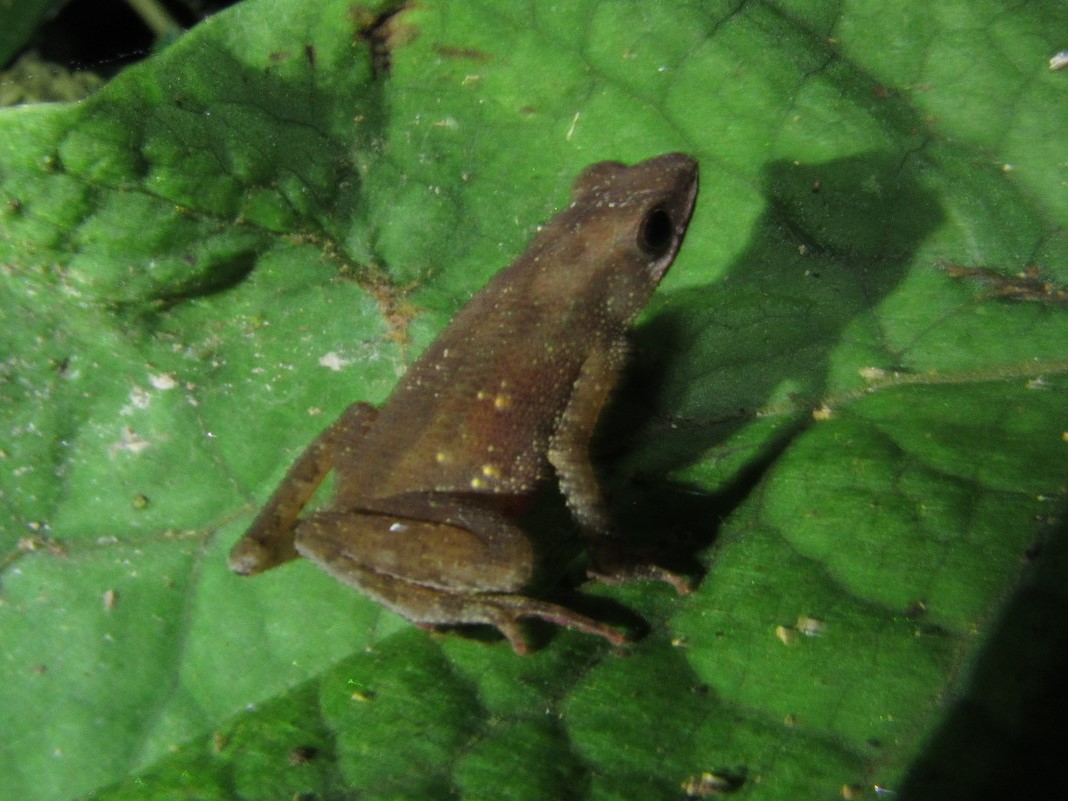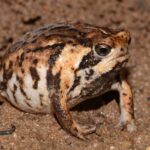- Amazophrynella siona: Secrets of an Enigmatic Amazonian Toad
- Introduction: A Tiny Sentinel Hidden in the Amazon
- Taxonomy and Classification: Understanding Amazophrynella siona
- The Amazon Rainforest Habitat: Microcosms of Biodiversity
- Physical Characteristics: Masters of Camouflage and Miniaturization
- Behavior and Life Cycle: Hidden Narratives Beneath the Foliage
- Ecological Role: Guardians of Rainforest Health
- Threats and Conservation Status: Fragile Lives in Changing Forests
- Cultural and Scientific Significance: Beyond Biology
- Conclusion: Embracing the Tiny Marvels of Our World
Amazophrynella siona: Secrets of an Enigmatic Amazonian Toad#
Introduction: A Tiny Sentinel Hidden in the Amazon#
Beneath the lush, dense canopy of the Amazon rainforest reside countless secrets, concealed in shadow, humidity, and vibrant biodiversity. Amidst this biological mosaic, a tiny yet fascinating creature quietly thrives, virtually unnoticed—the small, inconspicuous toad known scientifically as Amazophrynella siona. Barely known outside specialist circles, this amphibious enigma is a testament to the richness and complexity lying within one of Earth’s most remarkable ecosystems.
Measuring only about two centimeters, this diminutive toad might easily escape attention, yet belies its small stature with intriguing ecological significance. Discovered relatively recently in the detailed field surveys of western Amazonia, A. siona quickly captured biologists’ imaginations, presenting compelling insights into microhabitat specialization and amphibian diversity. But beyond its scientific intrigue lies a broader importance as an indicator species, sensitive to the profound environmental shifts occurring within our planet’s last great wilderness.
Taxonomy and Classification: Understanding Amazophrynella siona#
Amazophrynella siona belongs to the family Bufonidae, commonly referred to as true toads. This species inhabits the fascinating genus Amazophrynella, characterized mainly by their diminutive size and specialized adaptations to humid Amazonian habitats.
Named formally by researchers Jiménez de la Espada and colleagues, this species’ genus name—Amazophrynella—itself connects directly to its geographically expansive Amazonian origins. It emphasizes the deep-rooted adaptation and evolutionary path these amphibians have taken, anchored explicitly within the Amazon rainforest microhabitats.
Closely related species within this genus possess similarly tiny statures, specialized cryptic colorations, and habitat-dependent behaviors. Comparative studies of these species have uncovered subtle yet critical differences, insights that now shed critical light on the intricate evolution of minute amphibians and their precise ecological roles.
The Amazon Rainforest Habitat: Microcosms of Biodiversity#
Amazophrynella siona is known specifically from the western regions of the Amazon basin, with strongholds in Ecuador, Peru, and possibly adjacent areas in Colombia. It thrives in lowland tropical rainforests at elevations typically below 1000 meters, inhabiting microhabitats rich in leaf litter, moisture, and shaded detritus-carpeted forest floors.
A World Beneath the Leaves#
Walking silently through a healthy Amazonian forest, one may rarely indeed glimpse these tiny amphibians. But for the careful observer willing to stop, kneel, and gently sift through layers of damp forest litter, Amazophrynella siona might reveal itself. It is this leaf-litter world, dark and decomposing with vibrant fungal growths and countless small invertebrates bustling about, that forms the critical lifescape for this unobtrusive toad.
Here, humidity remains consistently elevated, something fundamental to their amphibious physiology. The decomposing leaves harbor prey items like springtails, mites, ants, and small spiders, providing ample feeding opportunities. Additionally, this forest layer provides cover from their primary predators—larger frogs, reptiles, birds, and small mammals—enabling these little amphibians to maintain a stealthy, inconspicuous lifestyle.
Physical Characteristics: Masters of Camouflage and Miniaturization#
At first glance, Amazophrynella siona may appear nondescript, clad in muted tones of soft brown and gray mottled with darker patterns. Such earthy hues blend seamlessly with the leaf litter and fallen vegetation of their habitat, making them nearly invisible to the casual observer. This spectacular camouflage serves as one of their most effective adaptations, providing essential protection against predators.
Their bodies, compact and robust relative to their small size, measure approximately 1.5 to 2 centimeters in length. Eyes, large in proportion to their tiny faces, are rimmed with darker pigmentation, aiding their vision in dim, shadowy environments. Although small, their hind limbs are surprisingly muscular, adapted for quick, explosive hops whenever a predator approaches or prey scurries by.
Particularly notable among their subspecies and relatives is their polished and generally smooth skin, unlike more famously “warty” toads from other regions. Scientists believe that this smoother texture minimizes moisture loss, a critical advantage for survival within tropical leaf-litter environments where drying out could spell swift demise.
Behavior and Life Cycle: Hidden Narratives Beneath the Foliage#
Little is officially documented about the full behavioral repertoire of Amazophrynella siona, though field observations provide valuable clues and compelling anecdotes. Its elusive nature and the remote, dense habitats it prefers make continuous, detailed study challenging. Nevertheless, researchers have pieced together a fascinating picture of this tiny toad’s life.
Dietary Habits and Foraging Strategies#
As a nocturnal insectivorous amphibian, its diet consists primarily of tiny arthropods abundant within the humid microhabitat it occupies. Small ants, springtails, mites, beetle larvae, and spiders form the bulk of its menu—carefully stalked or pounced upon quickly beneath hushed nighttime forests.
Mating Rituals and Breeding Habits#
Breeding is timed with seasonal rainfall fluctuations, typical for many rainforest amphibians. Male Amazophrynella siona toads make gentle, rhythmic calls, akin to delicate “clicks,” from hidden perches in damp vegetation or leaf-litter edges, enticing potential mates toward carefully protected breeding sites—small pools of standing water formed by rains. Their tadpoles develop in these ephemeral pools, quickly maturing to take advantage of brief habitat availability.
Ecological Role: Guardians of Rainforest Health#
Although tiny, the ecological significance of Amazophrynella siona extends far beyond its physical stature. Amphibians like this minute toad serve vital ecosystem roles as both predator and prey, forming integral links within the rainforest food web.
By consuming numerous small arthropods, they help maintain balanced insect populations, indirectly supporting plant health through reduction of herbivorous insect densities. Simultaneously, their vulnerability to chemical and environmental changes positions them perfectly as indicator species—canaries in the coal mine for scientists monitoring rainforest health.
Threats and Conservation Status: Fragile Lives in Changing Forests#
Currently, Amazophrynella siona has not been thoroughly assessed on the IUCN Red List, reflecting the limited knowledge about their abundances and distribution. Despite this lack of detailed assessment, their known dependence on specific microhabitats places them at possible risk from habitat fragmentation, deforestation, and global climate fluctuations. Rapid anthropogenic changes threaten the delicate balance of their specialized ecosystem, potentially imperiling their quiet existence.
Conservationists emphasize the urgent need for thorough research focused on taxonomy, life cycle, and population assessments, as only deeper understanding will allow for effective strategies to preserve species like A. siona and their delicate rainforest homes.
Cultural and Scientific Significance: Beyond Biology#
While not popularly famous outside scientific circles, tiny amphibians such as Amazophrynella siona represent a significant facet of rainforest biodiversity, helping us gauge forest health and resilience. Culturally, local indigenous communities have often celebrated amphibian life—even tiny toads—as symbols of renewal, purity, and the cyclical nature of tropical ecosystems. For ecologists and biological scientists, species like Amazophrynella siona provide a never-ending source of curiosity and inspiration, core to our planet’s narrative on biodiversity.
Conclusion: Embracing the Tiny Marvels of Our World#
In the comforting shadows of Amazonian forests, each species—no matter how diminutive or camouflaged—plays a unique role in the vast ecological tapestry maintaining planetary health. Understanding and conserving species like Amazophrynella siona reminds us vividly of Earth’s incredible diversity and fragility.
Let us stand united in protecting these secretive amphibians. After all, safeguarding their habitats means preserving our own.








